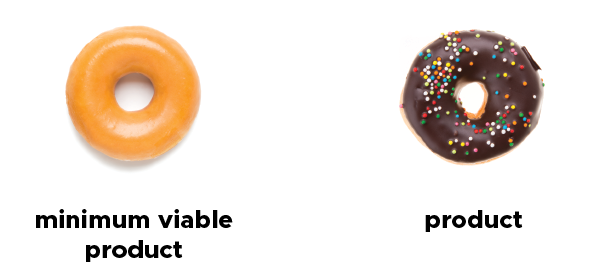Chapter 7 What is a minimum viable product (MVP)?
The MVP concept was made popular by Eric Ries in 2011 in his book, The Lean Startup. His methodology suggests that the question is not, ‘Can this product be built?’, but is in fact two questions: ‘Should this product be built?’ and ‘Can we build a sustainable business around this set of products and services?’
Figure 7.1 (overleaf) portrays perfectly what an MVP is. On the left is a plain doughnut, ready to eat. It represents the essence of an MVP: make something with the minimum functionality that enables it to be tested and then improve on it later. The elaborate doughnut on the right is the final product — the version that comes after you’ve launched the plain doughnut. To kickstart your business idea, start with the simplest version (a plain doughnut) and go from there.

Figure 7.1: the doughnut on the left is the basic version — the MVP. The doughnut on the right is the next iteration of that MVP. Get the simple doughnut to market first.
Why do you need an MVP?
When asked why businesses need an MVP, Bluewire Media’s digital marketing expert Adam Franklin says:
Where some entrepreneurs go wrong is they try to manufacture the fancy doughnut first. They spend too long developing it — getting the shape, the texture, the sprinkles, the icing just right — so by the time they launch it, a competitor has come along and scooped ...
Get How to Build an Online Business now with the O’Reilly learning platform.
O’Reilly members experience books, live events, courses curated by job role, and more from O’Reilly and nearly 200 top publishers.

